Fan for bathroom and toilet
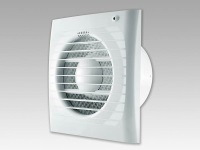
The fundamental condition for the comfortable use of the bathroom and toilet is the absence of excessive moisture, unpleasant odors and dampness on the walls.
In apartment buildings it has long been the norm to have natural exhaust ventilation. Unfortunately, it is not always sufficient to eliminate fumes and mustiness. And in this situation, the installation of an additional exhaust fan becomes a real necessity.
The lack of ventilation in the bathroom and restroom we all clearly felt in summer, when due to the heat evaporation and odors stagnated and even began to prevent breathing. This is predictable, since the principle of natural ventilation is based on the movement of air masses due to temperature differences, and in the warm season it is negligible.
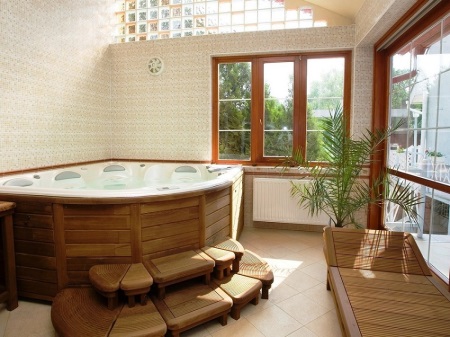
It is also undeniable that in older houses, the condition of the exhaust shafts leaves much to be desired. Dirt regularly accumulates in them over the years, and at some point they become impassable.
That's why more and more people are turning to installing an additional fan in the plumbing units to solve the problem of insufficient circulation. This measure helps with poor ventilation conditions in older homes and becomes a prevention of a similar problem in new construction.
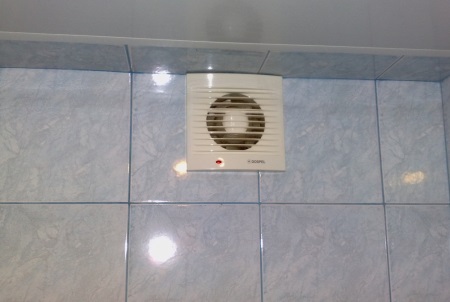
Types of exhaust fans
Let's begin our acquaintance with the variety of types of exhaust devices. Depending on their purpose among them allocate axial, radial, centrifugal (duct), as well as hoods for roofs.
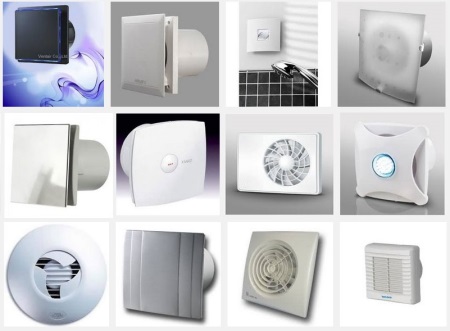
Axial
Axial exhaust units are constructed as vane impellers mounted in a cylindrical casing. The impeller is attached to the back of the electric motor rotor. The blades are placed at a slight inclination to the channel axis. The air is drawn in by the blades of the wheel and moves in the axial direction.
In order to intensify the work of the impeller, a grid collector is installed in front of the fan. Models with a similar principle of operation demonstrate a fairly high efficiency compared to other devices. The air flow rate exceeds 100 m3 /h, but at the same time they have a small head. The axial fan can be mounted directly in the wall.

Due to the uncomplicated installation, fans of this design are very common. Usually, the installation dimensions of axial fans coincide with the dimensions of exhaust shaft windows. The only undesirable moment - the work of such a hood can cause backward eddies inside the shaft. Also, it is worth noting the noticeable noise during operation of the device (about 30-50 dB), which can be annoying in everyday life.
Radial
In devices of this type, the impeller is placed in a spiral-shaped casing. The working body is made in the form of a barrel, on which the blades, parallel to the axis of rotation, are mounted with equal frequency. When rotating, the blades capture air and throw it to the inner surface of the casing. The spiral-shaped chamber compresses and moves the air flow along an inner duct to the discharge orifice.

The blades can be bent forward or backward, and the unit itself can suck air in one or both sides. The use of fans with backward-curved blades saves a lot of energy. In addition, their use is good to cope with increased loads when pumping large volumes. Fans with forward-curved blades show similar parameters of head and flow rate as the previous devices and at the same time have smaller impellers and the number of revolutions of the electric motor. This makes the unit smaller and slower.
Centrifugal
Centrifugal fans appeared later than others on the market, but already have a significant success among customers due to simplicity and ease of operation. Their use is justified in case of a large area of the room - from 15 m2 and more.
These devices combine high power, but at the same time remain low-speed. Duct fans evacuate air from the bathroom into the developed network of ventilation ducts. The duct in this case has a circular or rectangular cross-section. Duct fan with a system of outlets is customary to lay under the ceiling and concealed with drywall suspension.
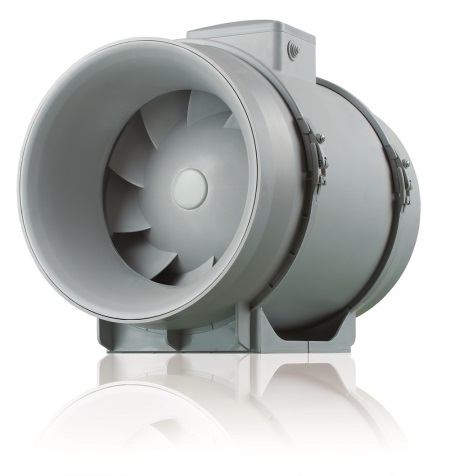
It is preferable to buy semi-flexible and non-bending ducts. They are more durable and can last longer than the flexible design. The fan itself, if desired, can be inserted inside the duct or at the inlet to the duct.
In the latter case, it is desirable to install additional equipment - anemostat. It prevents excess moisture and condensation from being drawn into the duct. But also with the installation of the fan in the depth of the outlet duct is not all simple. This creates additional aerodynamic losses and will weaken the thrust, you will have to choose a more powerful unit for this purpose.
Rooftop
Roof hoods are mounted directly on the roof of houses. Roof structures include an exhaust fan, its drive, gaskets for vibration dampening and automation devices. All this comes together in one case. Circulation in such devices is provided by axial or radial units with a large number of blades.
Guidelines for Selecting an Exhaust Fan
Choosing a particular manufacturer and model will require you to become familiar with the technical characteristics of fans, namely the performance and volume of suction air, noise level and moisture protection. It is also worth noting for yourself possibilities of adjustment, automation and price indicators.
Output .
It is also the flow rate. It shows the volume of air removed from the premises per unit of time. This indicator will determine the speed and completeness of the removal of water vapor from the bath. Average indicators of modern models are about 90-100 m3/h. Do not forget that the performance is directly related to the power consumed by the device. Therefore, increased energy expenditure may not be justified by the choice of an overly powerful fan.
Determining the optimal capacity for your case is easy. First, measure the room volume and set the number of circulation cycles per hour. Multiply the volume by the number of cycles to get the desired capacity.
The number of circulation cycles is determined by the purpose of the room and is regulated by building standards. For the bathroom it ranges from 6 to 8. If your apartment has 1-3 occupants, take the indicator to 6, if the occupants are more than 3 in the calculations use the number 8. The number of cycles for the toilet is from 6 to 10.
Having the calculated value of the capacity of the device in hand you can easily choose from the models offered by manufacturers the most inexpensive and with the minimum power consumption. When buying, focus on the fans with a slightly higher capacity than the calculated one.
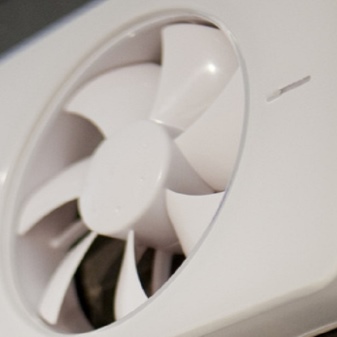
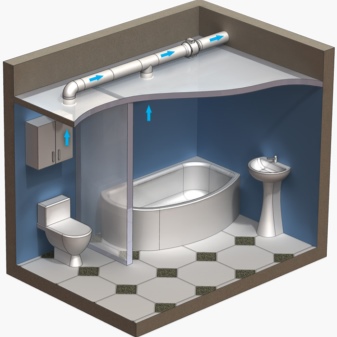
Noise level
No unit can work in complete silence. And yet, in order for the water procedures not to be accompanied by annoying buzzing, it is important to determine what noise characteristics the model you are considering has.
The characteristic operating volume of today's hoods varies from 25 dB and above. The human ear perceives a level over 35 dB as annoying sound. So, the operating volume of the appliance should be 30 dB maximum. And if you expect to leave the fan in operation at night, it should be up to 25 dB. You can find the volume figures in the technical documentation of the device. If possible, check the operating volume on site or check product reviews on the Internet.
Excessive noise can be eliminated by installing a muffler behind the impeller and by gluing insulation material inside the duct. Silencers can be in the form of tubes or plates mounted at a certain angle. Keep in mind that the duct clearance should not be reduced too much after insulation and silencers are installed, as this will create discharge air turbulence and air pockets.
Safety Issues
Among the points that are mandatory for the proper and safe functioning of the hood, the first place is the protection against the ingress of moisture. If condensation droplets get on conductive parts of the unit, such as motor terminals, there will be a short circuit. It is therefore better not to take any chances and to make sure that your appliance is safe from such situations.
First, an anemostat is installed - a plastic valve that is mounted in front of the air intake opening. It has a rim on the outside, in the middle of which a disc is movably fixed. The passage space between the disc and the rim varies depending on the thrust of the fan blades. The device creates an additional resistance in the way of air, which causes water vapor to condense. Droplets of condensation is captured by the filtering mesh of the anemostat itself.
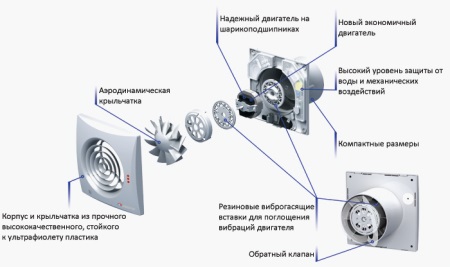
Secondly, be guided by the IP degree of dust and moisture protection of the device. Most of the presented models have at least IP34. In this particular case the decoding will mean protection against dust and particles 2.5mm and more in size and impermeability to splashes, flying from any side, inside the fan's motor casing. As you can see, this is already quite reassuring, but nothing stops you from aiming for a higher class of protection when choosing.
Functionality
It will be determined by the set of additional functions, the breadth of work settings and its automation. According to the level of functionality all existing devices can be divided into two groups.
Standard
Standard hoods are often axial units behind which a check valve is placed to block the movement of air from the ventilation back into the bathroom.
This type of unit starts when the lights in the room are turned on, and stops when the lights are turned off. No additional options are not provided. Still there are devices with a starting cord to turn on the hood, but who will want to reach for it all the time?
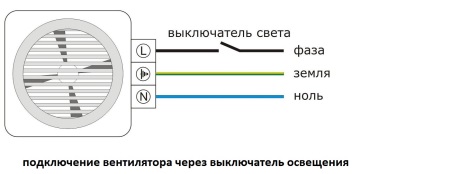
Automatic
Few people will be surprised with the modern level of automation independently actuated and turned off by the signal of temperature and humidity sensors of the fan, but you should agree - the innovation is very convenient. If you expect to simplify your life as much as possible, this is definitely your choice.
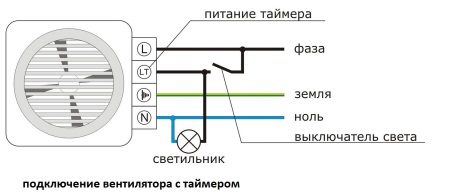
A common automation solution has been to tie the exhaust fan power to the light switches in the bathroom and toilet. It makes sense, but not always. In summer in particular, there is constant fumes from the drainage holes and the air gets stale. Here it is more relevant to tie on/off from the signal of the hygrostat.
All automatic fans have an off timer. You will be able to adjust the duration of operation of the device after it reacted to the signal of the inclusion. The setting range is wide - from 2 minutes to half an hour. This solution is good to avoid unnecessary waste of electricity.
Silent - features of the device
Silent fans can be called fans that operate at a volume limited to a limit of 25 dB. For clarity, let's explain that, being at arm's length from the operating device, you will not hear the noise of the motor and impeller.
The silent operation of these models has been achieved through a number of design innovations. Let's analyze them on the example of 3 main elements of the device:
1. Motor. The character of its attachment to the fan casing was changed. The noise from the running motor was the result of the vibrations transmitted to the whole casing while rotating. Now the vibrations are absorbed by the rubber bushes that fix the motor and do not let them resonate in the whole case.
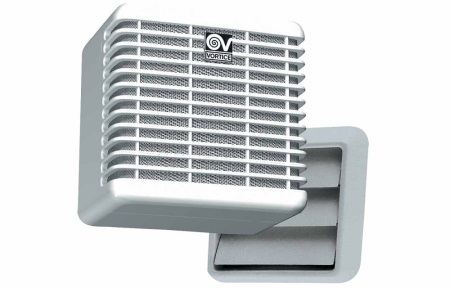
2. Housing. Previous housings served as very strong resonators because of the thin plastic. This is now corrected with a reinforced design made of thicker ABS plastic. Besides good noise absorption, this solution gave additional structural strength.
3. Bearings. The old ball bearings were a source of considerable noise from the rotating motor. The new bearings are manufactured with high precision, and their working parts have wear-resistant coatings. Smooth rolling of the rollers and balls is ensured by modern lubricants. As a consequence, runout and noise during rotation of the bearing is eliminated, and the noise level is audibly reduced many times over.
In addition to the above, the components of silent fans are manufactured with unprecedented accuracy (deviations within 0.01 microns). In such a situation all parts fit together perfectly, there are no misalignments and flimsy places, the presence of which has always been a source of additional noise.
Value for money
As we could already understand from the performance calculations, in the bathroom we need a more powerful and oversized fan, while a more modest version will do for the toilet. It is also worth realizing that you do not need an advanced protection against moisture and splashing in the toilet. In the bathroom, a normal axial fan is quite enough
Much more requirements are imposed on the ventilation of the bathroom. Both higher volume and higher circulation rate will require a more advanced and durable device. If you are faced with the question of choosing an exhaust hood for a new building, there is every reason to take a duct type fan as the quietest and at the same time the most productive.
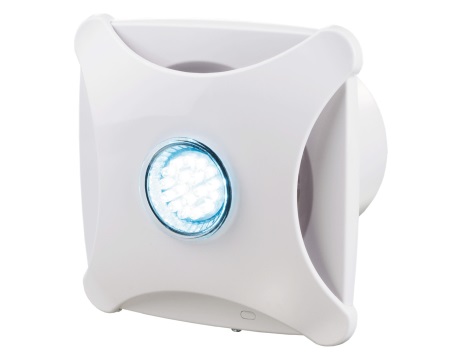
In a separate case, it is better to take axial or radial fans of silent type. This is if the room already has a window in the ventilation shaft. They cost in the range of 1500 rubles.
On the cost of devices with a timer switch off, we can say at once that they will cost 15 dollars more. In this case, the average price of standard devices - in the range 40-45 dollars.
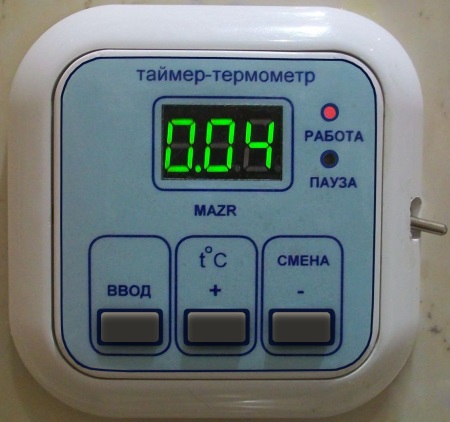
Fans advanced protection class will cost 20-25 c.u. more than standard devices. Fans with an advanced tuning system and the presence of lightning, temperature and humidity sensors will cost quite a bit - almost 2.5-3 times more expensive than standard models.
We can assure you that a quality product is not necessarily the most expensive. You can profitably buy the products of a domestic manufacturer and get a product that will surely last at least 3-5 years. But if you are interested in high functionality, you should seriously look into the existing range and read the reviews about the quality of products.
Installation of ventilation equipment
Suppose that additional work on the sound insulation of the ventilation system is not expected - the manufacturer has already taken care of that. Be that as it may, it is important to mount the device correctly to eliminate the emergence of additional noise due to resonance from parts of its body. This is possible when installing the fan in a duct or plasterboard partition. Let's consider the installation procedure in detail.
Mounting the overhead fan
In this example, the optimal mounting conditions are those in which the number of attachment points of the device to the surface is minimal. When it is not possible to reduce the number of fasteners, you can compensate for resonance by installing flexible inserts. Specialists suggest using a silicone cushion on which the fan sits as a compensator. It is easy to make any of you. It is enough to apply a 3-5 mm layer of silicone along the contour of the vent hole. When the mortar hardens, the cushion will allow you to fix the overhead hood without direct contact with the wall. Inside, the surface of the ventilation duct must not come into contact with the elements of the body of the appliance, for which we recommend lining the relevant places with soft rubber.
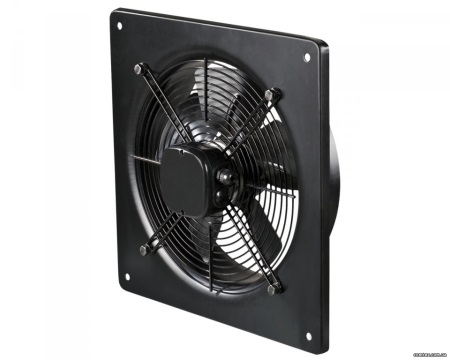
Installation of a duct fan
The situation is complicated by the need to isolate the device from the duct walls, which is difficult to do in domestic conditions. Here the role of compensators is played by inserts made of special corrugated rubber. The fan housing itself can not be held in the weight inside the laid pipes. It is correct to secure it with a clamp, which will be attached to a stud screwed into the ceiling. It is imperative that inserts be inserted between the clamp and the fan.
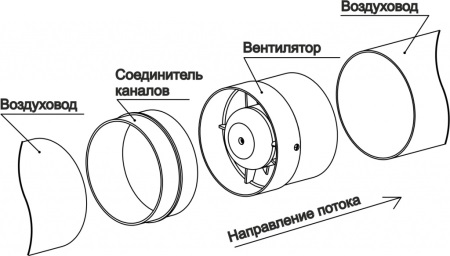
Since the installation of the hood will involve connection to a power source, here are A few requirements for wiring and connections.
1. According to safety rules, even insulated wires must not be placed openly in the bathroom (!). Wires must necessarily be placed in a special cable channel.
2. You can connect to the light switch through a contact pair, but it is preferable to bring the ends of the wire to a separate switch for safety and ease of repair switches.
3. In a wiring diagram for a timer device, you will need 3 wires: 1 ground wire and 2 power wires (for the timer and the switch).
That's all we wanted to tell you. We hope you found our tips helpful.





I have a room with a small pool in a private home of 20 square meters. I will buy a centrifugal fan.